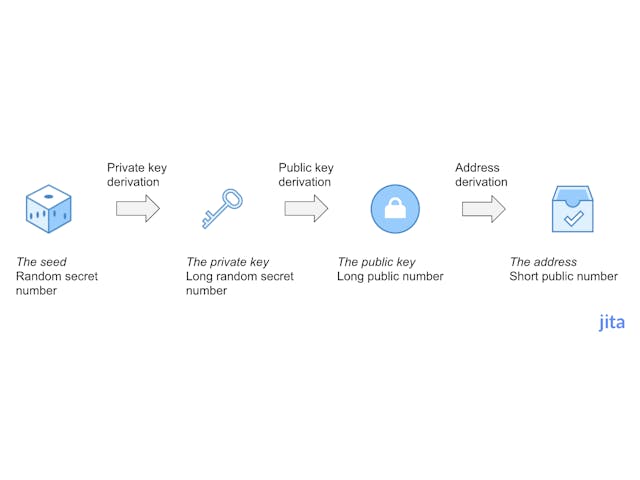
INSIGHTS / DLT-PRIVATE-KEY-AND-ADDRESS
July 2020
Keys and addresses in blockchain and DLT systems
Dr J. Rousselot
From random numbers to addresses
In most blockchain systems, addresses are the natural representation of an individual or a company. Blockchains addresses use numbers so long that they are virtually infinite, as they are coded on 256 bits. 2^256 ~ 10^168 (10 followed by 167 zeros addresses). This number of possible blockchain addresses is so huge it is almost impossible for us to appreciate it. Maybe for the best comparison, it is estimated that there are “only” 10^82 atoms (10 followed by 81 zeros) in the whole universe.
In all blockchain and DLT systems, every system participant has a secret private key, associated with a public key and a public address. These three concepts are all long numbers., with addresses being shorter than the others
Addresses are derived from a public key. The figure below illustrates how these concepts are interconnected. The private key is generated based on a random seed. The topic of random number generation is complex and outside the scope of this short introduction!

Modelling business processes with addresses
Each user has a unique secret private key and a unique public key and address. A user can send a transaction to another user. A transaction is a message signed using the user’s private key (proving his identity to the blockchain system). It can move any asset tracked by the blockchain, or call a function in a smart contract.
This means that business interactions between companies and/or individuals can be recorded, monitored and broadcast to other IT systems with no risk of duplicate or incorrect information. Therefore reducing uncertainty, improving information sharing, eliminating duplicate effort and accelerating business.
A blockchain address is like a phone number
A phone number is used to identify and access people connected to the telephone network. When someone gives us their phone number, they share their "phone identity" on the network. It looks like a random number. By typing this number into any device connected to the network, we know we can exchange voice and text messages with that person. In that sense, blockchain addresses are very similar to phone numbers. Instead of voice and text, we can exchange digital assets that represent financial or economic value.
A telephone network is controlled by a network operator, almost always tied to a country. Blockchain systems are open, global and decentralised by nature. This makes it easier for anyone to connect globally and exchange value. Permissioned blockchain systems enable organisations, consortiums and governments to leverage blockchain technology while maintaining control on access, content and exchange of digital assets. This way they too can make their IT systems more efficient, streamline their operations and transform their businesses to become more agile and dynamic.
Would you like to learn more?
If you enjoyed this article or would like to know more, please check out our use cases or get in touch to discuss your business case.